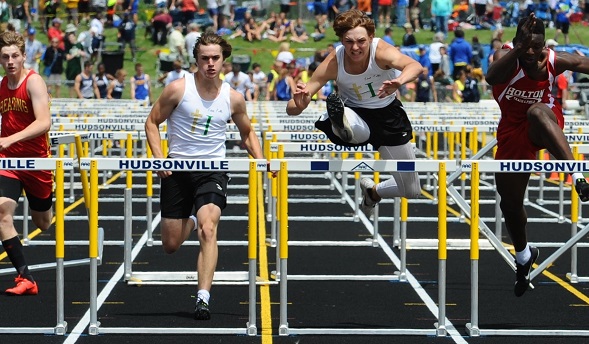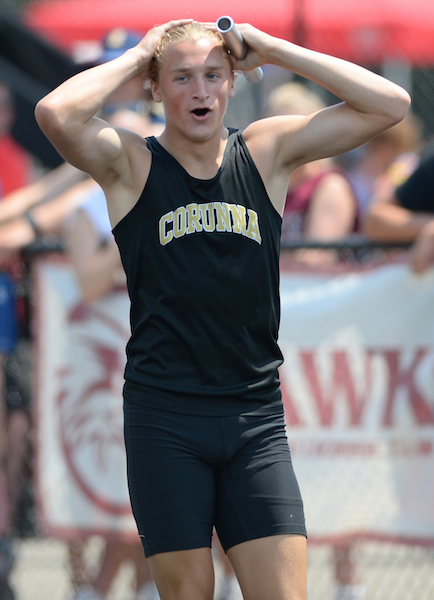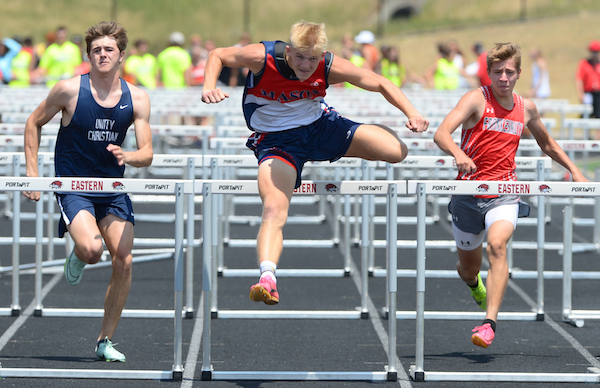
Hackett '6' Claim 1st Title Since 1930
By
Wes Morgan
Special for MHSAA.com
June 2, 2018
HUDSONVILLE – One day, when a Kalamazoo Hackett Catholic Prep track championship team reunion is in order, it won’t require much effort rounding everyone up.
With only six young men representing the Irish on Saturday at the Lower Peninsula Division 4 Finals at Hudsonville, head coach Simon Cholometes’ squad scored 51 points to win it all — the program’s first championship since 1930, when it was part of predecessor St. Augustine High School before boys began attending the newly-built Hackett High School in 1964.
All six Irish athletes made the all-state team, with junior Heath Baldwin leading the way with a pair of individual titles in the 110-meter hurdles (14.83 seconds) and the long jump (personal best 22 feet, 2½ inches).
After winning the hurdles, Baldwin paced around the infield with very little emotion.
“I kind of tried to come in with a cool and calm mindset,” he said. “I knew what I was capable of in the long jump and knew what I had to do for the 110s to win it. I’m just trying to stay relaxed. I know when I get too tight, good things are not going to happen.
“I came out and didn’t jump the way I wanted to. On my third jump, I really got my hips up and got the height I wanted.”
Sand Creek finished second with 36 points, and Breckenridge rounded out the top three with 33.
Hackett teammate Gus Magnell, a sophomore, was third in the 110 hurdles (15.14), and he ran a leg on the fifth-place 800 relay along with Christian Bartholomew, Eric Smith and Wade Poling. The quartet ran a time of 1:33.89. Bartholomew, Smith, Eric Wenzel and Magnell also placed fifth in the 400 (44.71).
Baldwin then nabbed a fourth-place time of 40.75 in the 300 hurdles, and Magnell secured the final all-state spot in eighth with a time of 41.20.
Magnell credited Cholometes for a drastic improvement in technique and the motivation to put in the extra work, and Baldwin for being, well, Baldwin.
“I would not be anywhere without my coach,” Magnell said. “To have a state champion you’re racing against every race, it really pushes you to keep getting better and better.”
“Those guys have a great relationship and they really feed off each other,” Cholometes added. “It’s very healthy competition with those guys, and they want to see each other do well.”
In the discus, Hackett sophomore Henry Zimmerman recorded a third-place toss of 145-10, and he made it a double all-state day with a sixth-place distance of 46-3 in the shot put.
Cholometes is in just his second year at Hackett after serving as an assistant coach at Sturgis, where he oversaw a sprint group that set several school records.
“It has been a quick turnaround for us,” Cholometes said of the culture shift for the program. “I did think it was possible. I knew we had to go out and perform to our potential, and we did that. These guys put a lot of work in last summer and this winter leading up to the season. It was all that work coming together today.
 “Heath is a pretty big-time performer, and he showed that today. Our sprint relays did well, as did Henry, scoring in both the throws. To win by [15 points] at a state meet, I was really pleased with that. Typically, it is pretty close.”
“Heath is a pretty big-time performer, and he showed that today. Our sprint relays did well, as did Henry, scoring in both the throws. To win by [15 points] at a state meet, I was really pleased with that. Typically, it is pretty close.”
Sand Creek’s Alec Muck was the only other double winner Saturday as the junior claimed titles in the 100 (10.98) and the 200 (22.02). He ran the same time in the 100 as he did when he won in 2017. Muck also was the reigning champion in the 200 after running a 22.14 last year.
The rest of the meet offered quite a variety for fans that packed the stadium. Fulton captured a title in the 800 relay after Tristan Johnston, Jon Baker, Adam Duflo and Nate Alwood combined for a time of 1:31.15. In the 3,200 relay, Hillsdale Academy’s Nick Rush, John O’Connor, Connor Oakley and Ian Calvert clocked a winning time of 8:14.88. The 400 relay title belonged to Breckenridge’s Lukas Ebright, Caleb Hurt, Hunter Collins and Caden Foster (44.00) and the 1,600 team from Concord comprised of Zeavion Jones, T.J. Kessman, Vincent Giuliano and Bryan Smith produced a first-place time of 3:30.96.
Also topping the podium were Ubly’s Alex Grifka in the 1,600 (4:27.90), Hale’s Patrick Harris in the 400 (50.04), Derek Flory, of Marcellus, in the 300 hurdles (39.49), Deckerville’s Stephen Barker in the 800 (1:56.82) and Wyoming Potter’s House Christian’s Nathan Stout in the 3,200 (9:44.08).
In the field events, Coleman’s Cody Finney won the discus (151-1), Sand Creek’s Cole Hallett cleared a winning height of 13-6 in the pole vault, Carson City-Crystal’s Daniel Smith had the best shot put of the day with a toss of 52-9, and Hillsdale Academy’s Peter Kalthoff was first in the high jump (6-5).
VIDEO: Alec Muck Runs To Double Wins – Again!
PHOTOS: (Top) Hackett’s Heath Baldwin and Gus Magnell, second and third from left, respectively, break through for two of top three places in the 110 hurdles. (Middle) Sand Creek’s Alec Muck pushes toward the finish line for one of his sprint championships Saturday. (Click for more from RunMichigan.com.)

Vicksburg's Wright, Corunna Right On in Claiming LPD2 Championships
By
Steve Vedder
Special for MHSAA.com
June 3, 2023
ADA – If Michael Wright was a baseball player, he probably would've been called out on strikes a year ago.
Instead, the Vicksburg senior can celebrate after winning the 200 at Saturday's Lower Peninsula Division 2 Track & Field Finals at Forest Hills Eastern.
The road to the championship in the 200, via a time of 21.72, was anything but a straight line for Wright. An aspiring baseball player, he was cut from the Vicksburg squad as a freshman. His football career, by Wright's own admission, was "on and off." And then a year ago in his first track meet, Wright suffered a leg injury that virtually ended his season. He did return to finish fifth in the 200 at Finals while helping the 400 relay team to a 16th place.
So there is nothing to realistically explain how Wright found himself in the position Saturday at sweltering Forest Hills Eastern to win a championship. Except for returning this season to break the school record in the 200 four times in two months. Well, that and willpower and simple desire.
 "I knew I could finish high, maybe in the top five. But this is better," said Wright, who credits drinking large quantities of milk for his resurgence. "I looked to football because I didn't think I could bounce back for track. But I overcame the bumps, the obstacles."
"I knew I could finish high, maybe in the top five. But this is better," said Wright, who credits drinking large quantities of milk for his resurgence. "I looked to football because I didn't think I could bounce back for track. But I overcame the bumps, the obstacles."
While Wright was jump-starting his track career, Corunna won the team title with 41 points. Mason and Forest Hills Eastern tied for second with 35. Whitehall was fourth with 33 points, and Frankenmuth fifth with 29 points.
Corunna coach Jeff Sawyer, who had never won a Finals title in 37 years coaching at Owosso and three more at Corunna, said the championship came after little fanfare during the season. Virtually right up until the time Corunna hauled off its first-place trophy, Sawyer said it was never really on his team's mind. The title came after the team managed only a runner-up finish at the Regional.
"We kind of low-keyed it," he said. "We knew scoring 40 points was possible. We lost to Frankenmuth by one point at the Regional. … We were a little disappointed we didn't win, but we had some good times today. We knew it was possible.
"Every day we just come and do what we do. We talk about getting better every day with PRs (personal records). And we're still getting better because we have some tough guys. Just competitive, tough kids. But we were the underdogs."
Corunna had only two firsts on Saturday, in the 400 relay (42.63) and Wyatt Bower in the long jump (22-8½).
Among the individual highlights was Frankenmuth senior Dalton DeBeau, who successfully defended his Finals title in the discus (171-6). He was fifth in that event as a sophomore and after winning a year ago, was considered a good bet to repeat.
"I kind of expected it," said DeBeau, who will compete at Michigan State next spring. "There wasn't a lot of pressure. I knew what had to be done. I threw 160 feet on my first throw to get in the finals, and that helped right away. I knew I could go all out."
 Berrien Springs' Jake Machiniak won the 100 (10.54) while the team also captured the 800 relay (1:28.18). Machiniak said his season hasn't been without its share of difficulties. There was a time when he couldn't seem to come out of the starting blocks smoothly. But beginning with the conference meet where he ran school record 10:73, Machiniak felt himself back on course.
Berrien Springs' Jake Machiniak won the 100 (10.54) while the team also captured the 800 relay (1:28.18). Machiniak said his season hasn't been without its share of difficulties. There was a time when he couldn't seem to come out of the starting blocks smoothly. But beginning with the conference meet where he ran school record 10:73, Machiniak felt himself back on course.
"There were ups and downs. I struggled in the middle of the season," he said. "But my teammates helped me through some difficulties. I came here to finish the job; I knew I could do something here."
Mason's Tyler Baker won the 100 hurdles (14.63) to complete a long journey that included finishing just ninth in last year's prelims. The success was as simple as putting in loads of offseason work.
"I practiced and did stuff about every day," he said. "I might not be the fastest, but I make up for that in form. It's a fine-tuning thing. Everyone wants to be faster."
Mason also got a championship from A.J. Mantel, who captured the 300 hurdles (38.90).
Among other highlights was Forest Hills Eastern senior Aiden Sullivan successfully defending a 2022 title on his own home turf. He won Saturday's 800 (1:53.92).
Adrian won the 3,200 relay (7:39.77), while Grand Rapids Christian took the 1,600 (3:24.49).
Alma had two individual winners in Michael Howey in the shot (55-08) and Jacob Dunlap in the high jump (6-7).
The other champs were Kyle Eberhard of Linden in the 1,600 (4:14.79), Whitehall's Trannon Ayler in the 400 (48.83), Freeland's T.J. Hansen in the 3,200 (9:11.56) and Sam Vesperman of Grosse Ile in the pole vault (15.01). Chelsea senior Jacob Nelson competed in the adaptive 100 (27.28), 200 (57.71) and shot put (6-6).
PHOTOS (Top) Vicksburg's Michael Wright celebrates after winning the 200 on Saturday. (Middle) Corunna's Tarick Bower enjoys a moment after anchoring the winning 400 relay. (Below) Mason's Tyler Baker, center, works to stay ahead in the 110 hurdles. (Photos by Dave McCauley/RunMichigan.com.)

